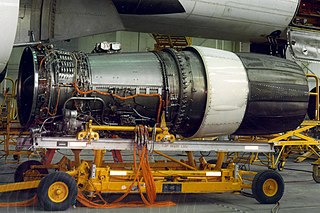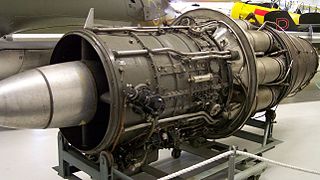| TRS 18 | |
|---|---|
 | |
| Type | Turbojet |
| National origin | France |
| Manufacturer | Microturbo SA |
The Microturbo TRS 18 is a small, low thrust turbojet designed and built in France in the 1970s. It was installed on both manned and unmanned aircraft.
| TRS 18 | |
|---|---|
 | |
| Type | Turbojet |
| National origin | France |
| Manufacturer | Microturbo SA |
The Microturbo TRS 18 is a small, low thrust turbojet designed and built in France in the 1970s. It was installed on both manned and unmanned aircraft.
The TRS 18 was originally designed for self-launching motor gliders but was adapted to power conventional ultralight aircraft and unmanned vehicles (RPV). It was originally designed and developed by Sermel, a competitor company to Microturbo which the latter took over in 1971. [1] It is a simple, low thrust, reverse flow single shaft engine with a centrifugal compressor and axial turbine. It is built in three modules: an intake section containing starter and lubrication systems; a centre section with compressor and turbine on ball bearings; and an aft section with the folded combustion chambers and tail-pipe. [2]
It gained its US Federal Aviation Administration type certificate in May 1976. [2]
Data from Jane's All the World's Aircraft 1984-85 [2]
Data from Jane's All the World's Aircraft 1984-85 [2]
Manned
Unmanned
Data from Jane's All the World's Aircraft 1984-85 [2]

The General Electric F101 is an afterburning turbofan jet engine. It powers the Rockwell B-1 Lancer strategic bomber fleet of the USAF. In full afterburner it produces a thrust of more than 30,000 pounds-force (130 kN). The F101 was GE's first turbofan with an afterburner.

The General Electric/Allison J35 was the United States Air Force's first axial-flow compressor jet engine. Originally developed by General Electric in parallel with the Whittle-based centrifugal-flow J33, the J35 was a fairly simple turbojet, consisting of an eleven-stage axial-flow compressor and a single-stage turbine. With the afterburner, which most models carried, it produced a thrust of 7,400 lbf (33 kN).

The General Electric/Allison J33 is an American centrifugal-flow jet engine, a development of the General Electric J31, enlarged to produce significantly greater thrust, starting at 4,000 lbf (18 kN) and ending at 4,600 lbf (20 kN) with an additional low-altitude boost to 5,400 lbf (24 kN) with water-alcohol injection.

The Williams FJ33 is an American family of turbofan jet engines intended for use in very light jet aircraft. The FJ33 is a scaled-down version of the FJ44 engine. The FJ33-5A is the latest version certified in June 2016.

The Pratt & Whitney Canada PW300 series is a family of turbofan jet engines developed by Pratt & Whitney Canada specifically for business jet applications.

The Turbomeca Marboré is a small turbojet engine that was produced by Turbomeca from the 1950s into the 1970s. The most popular uses of this engine were in the Fouga CM.170 Magister and the Morane-Saulnier MS.760 Paris. It was also licensed for production in the United States as the Teledyne CAE J69.

The CFE CFE738 is a small turbofan engine aimed at the business/commuter jet market manufactured by the CFE Company, and is used on the Dassault Falcon 2000.

The Mirach 150 is a reconnaissance unmanned aerial vehicle (UAV) developed in Italy in the 1990s. A turbojet-powered machine, it is apparently a derivative of the Mirach 100 series of targets, being of the same general size and also powered by a Microturbo TRS-18-1 turbojet.

The Turbomeca Aubisque was a small turbofan engine designed and produced by Turbomeca in the 1960s. Its only application was the Saab 105 military trainer aircraft as the RM9. The engine is named after the Col d'Aubisque in the Pyrenees mountains, in line with company tradition.

The Motorlet M-701 is a Czechoslovak jet engine. It was used to power the Aero L-29 Delfín jet trainer, with about 9,250 engines built between 1961 and 1989.
The Garrett F109 was a small turbofan engine developed for the Fairchild T-46 by Garrett AiResearch. With the United States Air Force's cancellation of the T-46 program in 1986, further development of the engine ceased, and with it the civil TFE109 version.

The Power Jets W.1 was a British turbojet engine designed by Frank Whittle and Power Jets. The W.1 was built under contract by British Thomson-Houston (BTH) in the early 1940s. It is notable for being the first British jet engine to fly, as the "Whittle Supercharger Type W1", powering the Gloster E.28/39 on its maiden flight at RAF Cranwell on 15 May 1941. The W.1 was superseded by the Power Jets W.2.
The Microturbo TRI-40 is a small turbojet engine developed for use in cruise missiles and small unmanned aerial vehicles in the 2.2 - 3.6 kN thrust class.

The Microturbo TRI 60 is a small, expendable turbojet engine developed for use in cruise missiles, target drones, and other small unmanned air vehicles. Variants of this engine produce from 3.5 to 5.3 kN of thrust. The engine first ran in 1974.

The Teledyne CAE J402 is a small turbojet engine. Several variants have been developed to power unmanned air vehicles such as missiles and target drones. Developed in the 1970s for the Harpoon anti-ship missile, the J402 was the first jet engine to be designed as a "wooden round", meaning that the engine had to be able to sit for long periods without maintenance or inspection and work right away.
The Flader J55, also known as the 124 within the company, was a small turbojet engine notable for its use of a supersonic axial-flow compressor. Development started at Fredric Flader Inc. in 1947, with the first examples being delivered in 1949. However, these delivered far lower power than predicted. Improved models followed in early 1952 that met the performance requirements, but demonstrated very poor reliability. When small engines from other companies became available, the J55 project was cancelled in 1952.
The West Engineering XJ38 was a small turbojet engine created by modifying World War II-surplus aircraft engine turbosuperchargers. Intended to be a cheap method of producing jet engines for target drones for the United States Navy, the latter lost interest in the project, which was soon discontinued because of lack of funding.

The STAL Dovern was a Swedish turbojet design of the early 1950s, named after a lake in Finspång municipality in Östergötland, Sweden. Intended to power the Saab 35 Draken, this aircraft was powered by the Rolls-Royce Avon instead. The Dovern did not enter production.
The Turbomeca Piméné was a small French turbojet engine produced by Turbomeca in the early 1950s.
The Turbomeca Aspin was a small French turbofan engine produced by Turbomeca in the early 1950s. This geared turbofan design was the first turbofan to fly, powering the Fouga Gemeaux test-bed aircraft on 2 January 1952.